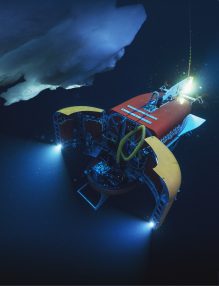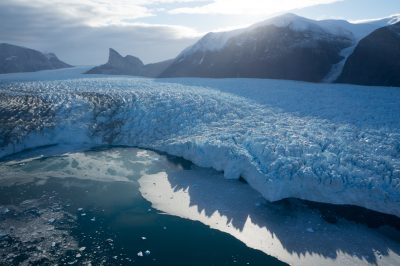Undersea Glacier Robot
December 5, 2022


It’s the front line of climate change and could hold the key to predicting global sea level rise, but what goes on at the underwater face of Greenland’s glaciers is a mystery to science.
That could change in 2023 with a bold new mission led by researchers at the Jackson School of Geosciences that will explore three of Greenland’s glaciers with a submersible robot. The voyage will be the first time Greenland’s glaciers — which make up the world’s second-largest ice sheet — will be seen up close underwater.
Engineered to survive ice-covered seas by project partner the Woods Hole Oceanographic Institution, the remotely operated vehicle Nereid Under Ice (NUI) will brave icebergs and riptides to approach within feet of the glaciers and return with data and samples from their underwater environment.
The scientists’ primary focus is not glacial ice, but the natural sand walls — or moraines — that buttress the glaciers and are thought to naturally, but precariously, stabilize the ice sheet. What they learn will reveal what’s shoring up glaciers across the entire Greenland ice sheet, which could lead to more accurate model projections for future sea level rise.
“The big uncertainty in Greenland’s contribution to sea level rise is how fast the ice sheet is going to lose mass,” said Ginny Catania, a professor in the Department of Geological Sciences and a research associate at the University of Texas Institute for Geophysics. “We know how much sea level is stored in the ice sheet, we know climate is warming and changing the ice sheet, but what we don’t know is the rate at which these glaciers will contribute to sea level rise.”

The project is funded by the W.M. Keck Foundation, one of the nation’s largest philanthropic organizations, which supports outstanding science, engineering and medical research. The mission will investigate three glaciers in western Greenland that lie in the path of warming Atlantic waters but have responded to climate change in different ways. Since 2000, Kangilliup Sermia has experienced only minor retreat, Umiammakku Sermiat retreated rapidly before stabilizing in 2009, and Kangerlussuup Sermia has remained largely unaffected by warming.
The information could also be crucial for future geoengineering projects. Some scientists have suggested building artificial moraines as a way of buying time while the world transitions to low-carbon energy sources.
NUI will make its way underwater to each glacier’s face, mapping the seafloor topography as it goes. Once at its target site, operators aboard a nearby support ship will remotely guide the robot’s manipulator arm to retrieve sediment cores from the glacier’s moraines. The vehicle will also gather samples from the massive sediment plumes jetting from under the glaciers.
Back to the Newsletter